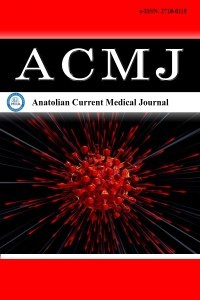1.
WHO Coronavirus (COVID-19) Dashboard. Available online:https://covid19.who.int/ 2022
2.
Guan WJ, Liang WH, Zhao Y, et al. Comorbidity and its impacton 1590 patients with COVID-19 in China: a nation wideanalysis. Eur Respir J 2020; 55: 2000547.
3.
Ersan G, Rollas K, Atalay S, et al. [Analysis of 65 years old andover patients with full dose vaccination by inactive vaccine andwithout vaccination admitted to hospital with SARS-Cov-2 PCRpositivity]. Klimik Derg 2022; 35: 64-7.
4.
Chen Y, Klein SL, Garibaldi BT, et al. Aging in COVID-19:Vulnerability, immunity and intervention. Ageing Res Rev 2021;65: 101205.
5.
Tregoning JS, Flight KE, Higham SL, Wang Z, and Pierce BF.Progress of the COVID-19 vaccine effort: viruses, vaccinesand variants versus efficacy, effectiveness and escape. Nat RevImmunol 2021; 21: 626-36.
6.
Gavriatopoulou M, Stathopoulos IN, Korompoki E, et al.Emerging treatment strategies for COVID-19 infection. Clin ExpMed 2021; 21: 167-79.
7.
Wang Q, Yang L, Jin H, Lin L.Vaccination against COVID-19:A systematic review and meta-analysis of acceptability and itspredictors. Prev Med 2021; 150: 106694.
8.
Johnson AG, Amin AB, Ali AR, et al. COVID-19 ıncidence anddeath rates among unvaccinated and fully vaccinated adults withand without booster doses during periods of delta and omicronvariant emergence—25 U.S. Jurisdictions, April 4-December 25,2021. MMWR Morb Mortal WklyRep 2022; 71: 132-8.
9.
Xu S, Huang R, Sy LS, et al. COVID-19 Vaccination and Non-COVID-19 Mortality Risk - Seven Integrated Health CareOrganizations, United States, December 14, 2020-July 31, 2021.MMWR Morb Mortal Wkly Rep 2021; 70: 1520-4.
10.
Bernal JL, Andrews N, Gower C, et al. Effectiveness of the Pfizer-BioNTech and Oxford-AstraZeneca vaccines on COVID-19related symptoms, hospital admissions, and mortality in olderadults in England: test negative case-control study. BMJ 2021;373: n1088.
11.
Haas EJ, Angulo F, McLaughlin JM, et al. Impact and effectivenessof mRNA BNT162b2 vaccine against SARS-CoV-2 infectionsand COVID-19 cases, hospitalisations, and deaths following anationwide vaccination campaign in Israel: an observationalstudy using national surveillance data. Lancet 2021; 397: 1819-29.
12.
Tenforde MW, Self WH, Adams K, et al. Association betweenmRNA vaccination and COVID-19 hospitalization and diseaseseverity. JAMA 2021; 326: 2043-54.
13.
Onder G, Rezza G, Brusaferro S. Case-fatality rate andcharacteristics of patients dying in relation to COVID-19 in Italy.JAMA 2020; 323: 1775-6.
14.
Wu Z, Mc Googan JM. Characteristics of and important lessonsfrom the coronavirus disease 2019 (COVID-19) outbreak inChina: Summary of a report of 72 314 cases from the ChineseCenter for Disease Control and Prevention. JAMA 2020; 323:1239-4.
15.
Wu C, Chen X, Cai Y, et al. Risk factors associated with acuterespiratory distress syndrome and death in patients withcoronavirus disease 2019 pneumonia in Wuhan, China. JAMAIntern Med 2020; 180: 934-43.
16.
Garibaldi BT, Fiksel J, Muschelli J, et al. Patient trajectoriesamong persons hospitalized for COVID-19: a cohort study. AnnIntern Med 2021; 174: 33-41.
17.
Durusu-Tanriover M, Doğanay HL, Akova M, et al. Efficacyand safety of an inactivated whole-virion SARS-CoV-2 vaccine(CoronaVac): interim results of a double-blind, randomised,placebo-controlled, phase 3 trial in Turkey. Lancet 2021; 398:213-22.
18.
Mok CKP, Cohen CA, Cheng SMS, et al. Comparison of theimmunogenicity of BNT162b2 and CoronaVac COVID-19vaccines in Hong Kong. Respirology 2021; 7: 301-10.
19.
Dagan N, Barda N, Kepten E, et al. BNT162b2 mRNA COVID-19vaccine in a nationwide mass vaccination setting. N Engl J Med2021; 384: 1412-23.
20.
Bernal JL, Andrews N, Gower C, et al. Effectiveness of the Pfizer-BioNTech and Oxford-AstraZeneca vaccines on COVID-19related symptoms, hospital admissions, andmortality in olderadults in England: test negative case-control study. BMJ 2021;373: n1088.
21.
Mhawish H, Mady A, Alaklobi F, et al. Comparison of severityof immunized versus non-immunized COVID-19 patientsadmitted to ICU: A prospective observational study. Ann MedSurg (London) 2021; 71: 102951.
22.
Olson SM, Newhams MM, Halasa NB, et al. Effectiveness ofBNT162b2 vaccine against critical COVID-19 in adolescents. NEngl J Med 2022; 386: 713-23.
23.
Muthukrishnan J , Vardhan V , Mangalesh S, et al. Vaccinationstatus and COVID-19 related mortality: A hospital based crosssectional study. Med J Armed Forces India 2021; 77: 278-82.

